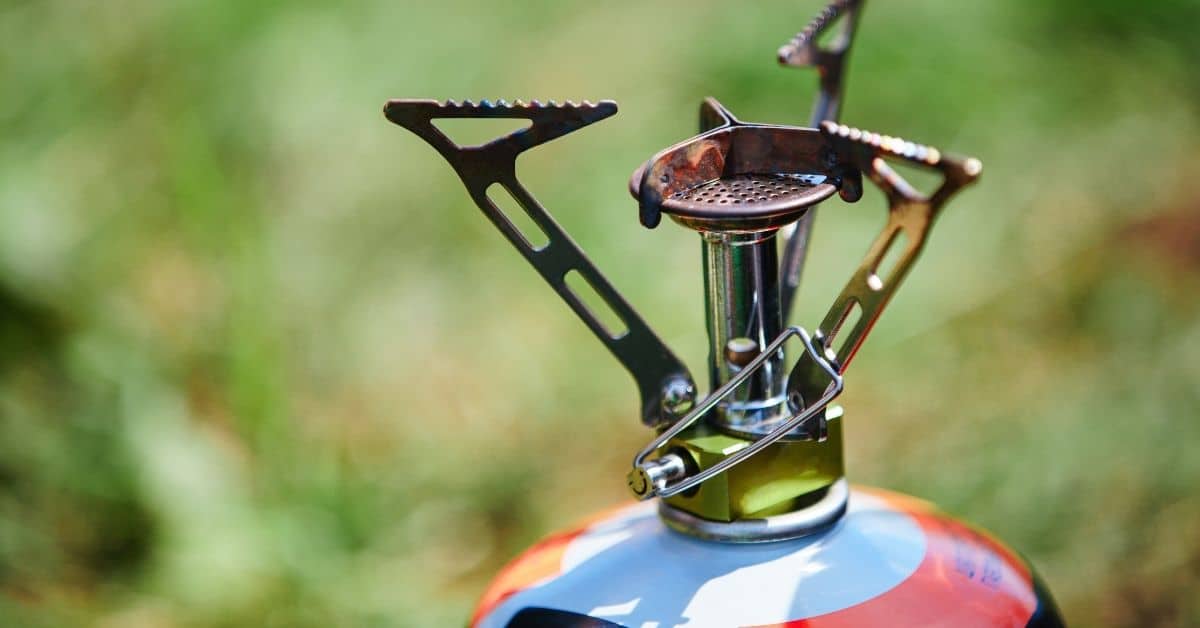There’s nothing quite like a hot meal after a long day of hiking or a warming cup of coffee after a chilly night spent camping outdoors. Whether you’re out on a multi-day backpacking trip or just spending a weekend in the woods, having a reliable camping stove can make all the difference.
Not only does it allow you to cook delicious meals and brew up a fresh cup of coffee, but it also provides a sense of comfort and warmth that can be hard to come by in the wilderness.
As a backpacker, weight and size are crucial factors to consider when selecting a stove that meets your needs. With so many options available, it can be overwhelming to choose the best camping stove for your wild camping trip.
In this guide, we’ll explore the best camping stoves on the market, covering the most important features and providing you with all the information you need to make an informed decision. I have ranked and reviewed the 9 of the best camping stoves, along with my top 5 choices, so that you can pick the best one for your next backpacking trip.
So, let’s get ready to heat things up and elevate your camping experience with the perfect camping stove!
What Are The Best Camping Stoves?
When choosing a camping stove, you will want to consider factors like the type of camping you’ll be doing, the type of fuel the stove uses, the stove’s cooking power and efficiency, its durability and ease of use, and any additional features. Considering these factors will help you select the best camping stove for your specific needs.
The choice is up to you.
Here are my top picks for the best camping stoves this year.
Best Overall

MSR PocketRocket 2
- Lightweight stove – only 75 grams
- compact yet powerful screw-on gas stove
- Reliable and powerful burner
Editors Pick: FireMaple Polaris (Save 10%)
Best All-in-One Stove System: Jetboil Flash
Best All-in-One Stove System with Simmer Control: Jetboil MiniMo
Best for Travel and Cold Conditions: MSR Whisperlite International
Best for Wind Resistance: MSR WindBurner Stove System
Affiliate Disclaimer: This article contains affiliate links. Purchasing through these links supports this site at no extra cost to you.
Learn more here.

MSR PocketRocket 2
Best Overall Canister Stove
Fuel type: Butane/propane gas canister
Weight: 75g
Boil time (1L): 3.5 minutes
What I like: Lightweight, compact, inexpensive, and powerful burner.
What I dislike: Not as stable or windproof as other options.
The MSR PocketRocket 2 is a lightweight, compact stove that is easy to use and carry. It has a durable design, and it is very easy to clean.
Although small, this remarkably stable screw-on gas stove packs a punch! Plus, its compact size means it takes up very little space in your backpack. This stove is very easy to operate and offers precision flame control and with its three serrated arms will nicely handle pots of various sizes.
The MSR PocketRocket 2 works great for backpacking trips or any other outdoor activity where weight is an issue – it weighs just 75 grams! Additionally, it comes with a durable hardshell carrying case suitable for travel.
This means that if you’re looking for something reliable but still want something small enough to take along on your adventures without adding too much bulkiness or weight, this could be the perfect choice for you!
Upgrade: The MSR PocketRocket Deluxe is an upgraded version of the PocketRocket 2 stove, featuring a push button igniter, a pressure regulator to aid in cold temperatures and high altitudes, and a recessed burner head that enhances its performance in windy conditions. For a comprehensive cooking solution, campers can opt for the MSR PocketRocket Deluxe Stove Kit which includes a pot, bowl, and pot lifter.
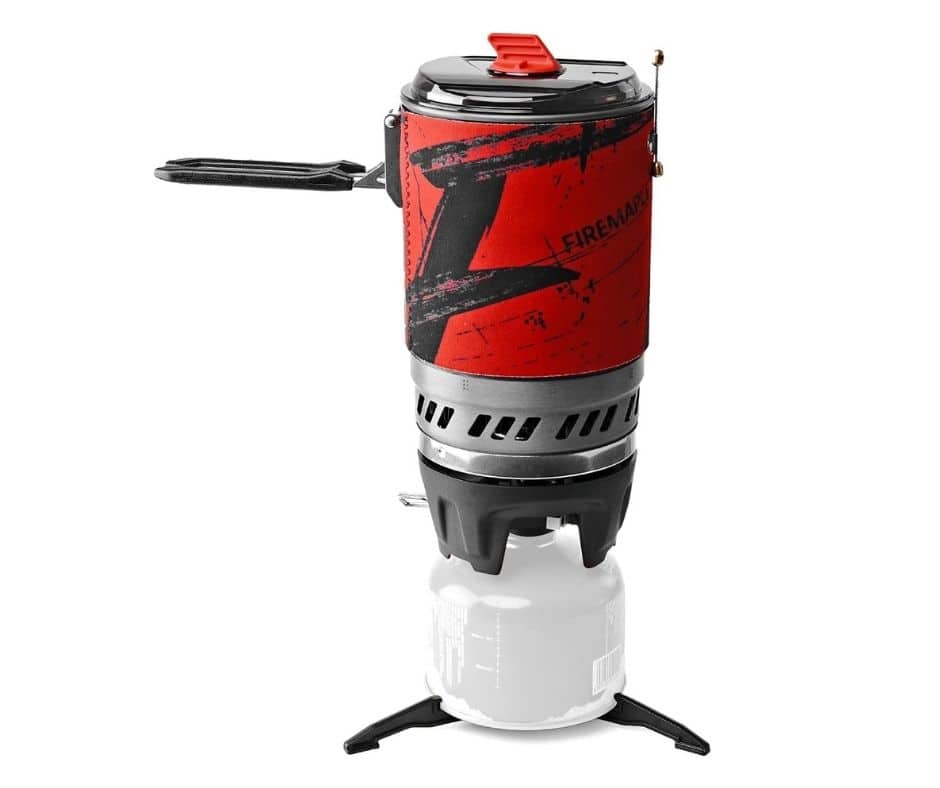
FireMaple Polaris
Editors Pick
Fuel type: Butane/propane gas canister
Weight: 622g
Boil time (1L): 220 seconds
What I like: Great price for an all-in-one cooking system, push-button Piezo igniter, simmer control plus works great in cold or harsh environments.
What I dislike: On the heavy side compared to others on this list.
The FireMaple Polaris is an excellent stove for those who are looking for a versatile cooking experience on the trail. Its micro-regulating technology allows for incremental heat adjustments, perfect for everything from simmering sauces to full-blown stir-frying. The stove maintains consistent heat output even under variable environmental conditions, ensuring your meal prep is as smooth as possible.
Weighing in at 622g, it’s not the lightest option on the market but what it lacks in lightweight design, it makes up for in performance and durability. Built from anodized aluminium and stainless steel, the Polaris is a sturdy and reliable companion for your outdoor adventures.
One of the standout features has to be the push-button igniter, which makes starting the stove a breeze, especially in colder temperatures. In fact, it’s been designed to function well down to 20 degrees F (-6 degrees C), making it a good pick for those who like to camp in colder climates.

The stove comes complete with a mesh bag for easy storage, and its folded dimensions are quite compact, making it easier to pack.
Overall, the FireMaple Polaris offers all the best features you’d find in a higher-priced stove like the Jetboil but at a significantly lower price point. The only compromise here is the weight. Its micro-regulating technology and impressive build quality make it a standout option for the versatile outdoor chef who doesn’t want to break the bank.
Follow this link to save 10% with the code: STEVE10
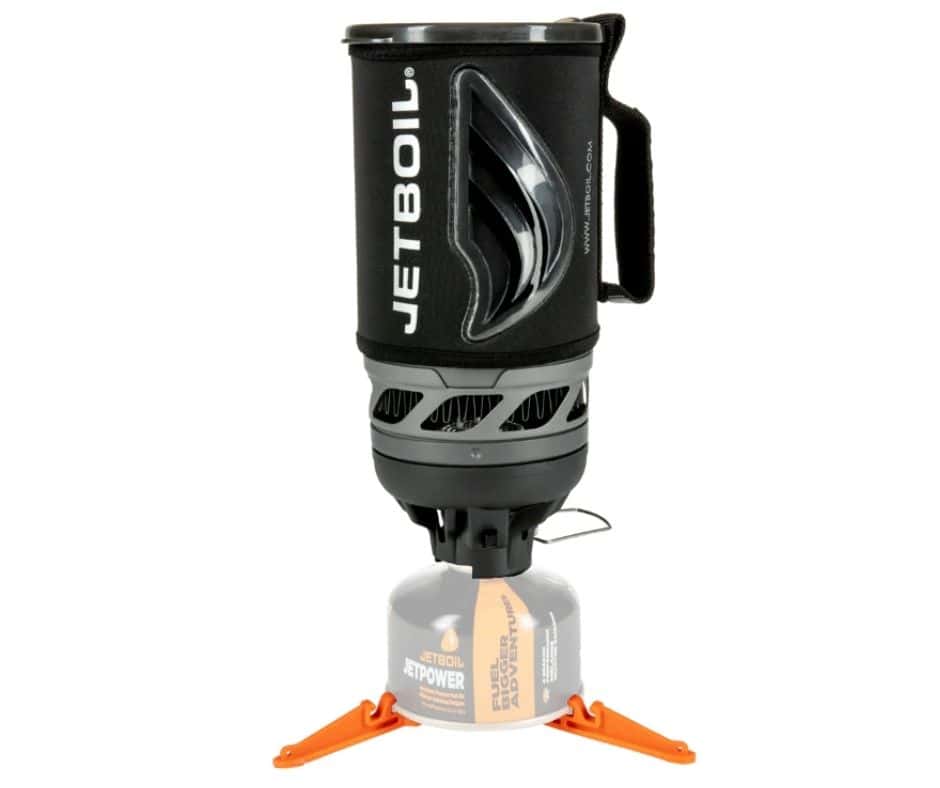
Jetboil Flash
Best All-in-One Stove System
Fuel type: Butane/propane gas canister
Weight: 371g
Boil time (1L): 100 seconds
What I like: Compact, insulated pot included, fast boil time, push-button igniter, performs well in wind.
What I dislike: Small pot size, not versatile, no simmer control
The Jetboil Flash stove is great for boiling water with the ability to boil 1 litre of water in just 100 seconds, perfect for making a quick cup of coffee or tea in the morning after a night camping making it a great choice for backpackers who value speed and convenience.
For backpackers, integrated stoves may not be the lightest option, but they are definitely the most convenient and fastest way of boiling water – which is usually all most backpackers need for their dehydrated meals and hot drinks.
The integrated fuel canister ensures that you won’t lose your fuel in transit or at camp. The design is also very good with a small flame that provides even heat distribution across the bottom of your pot or pan.
One of the best features of this gas cooker is the push-button igniter, which makes it quick and easy to use. You don’t have to struggle with matches or lighters to get it started. The thermochromatic colour change heat indicator is also a great addition as it lets you see exactly when the water is hot and ready. You don’t have to guess or keep checking, which saves time and energy. The insulating sleeve is another bonus, as it keeps the water hot for longer.
Upgrade: If you are a big coffee drinker like me then you may like me then you’ll love the Jetboil coffee press which turns your Flash into a french style coffee press to make the perfect cup of coffee on the go. Jetboil also offers the Flash 2.0 Java Kit Backpacking Stove which includes the coffee press.
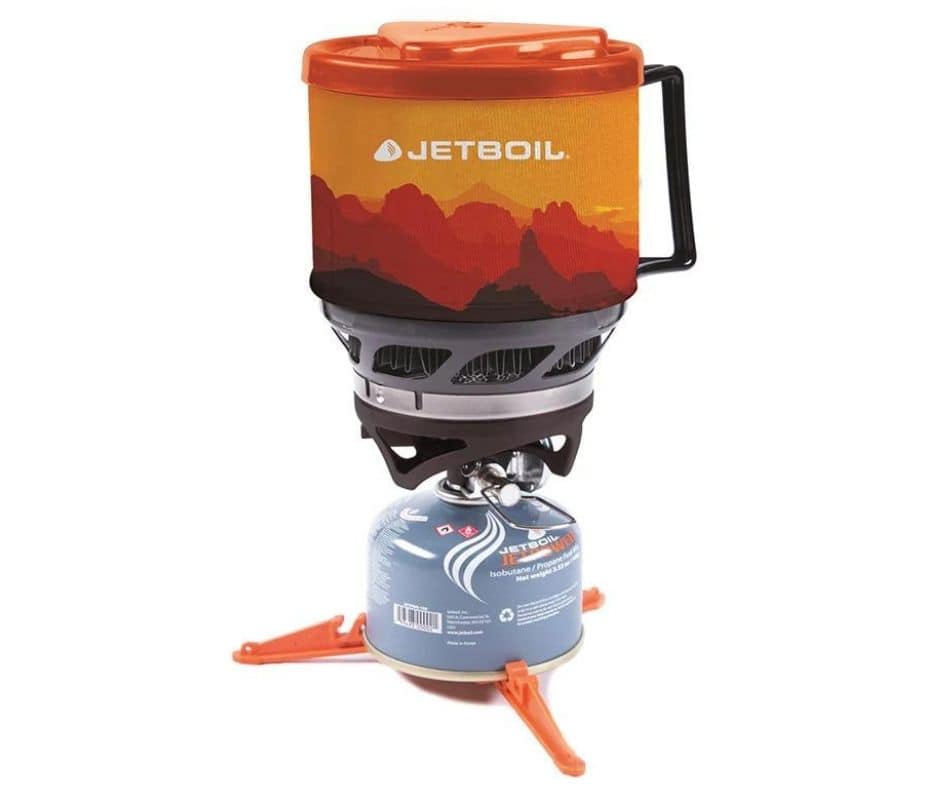
Jetboil MiniMo
Best All-in-One System with Simmer Control
Fuel type: Butane/propane gas canister
Weight: 415g
Boil time (1L): 2.3 minutes
What I like: Simmer control, compact, insulated pot included, push-button igniter, performs well in wind.
What I dislike: Slower boil time than the flash and expensive
The Jetboil MiniMo is an impressive all-in-one cooking system that is perfect for anyone who wants more than just boiling water. With its upgraded temperature regulator, the MiniMo offers impressive simmer control, allowing users to cook their meals to perfection.
Its 1-litre cooking pot is wrapped in a neoprene sleeve for safe handling whilst also keeping your contents warmer for longer, and its short and stout build provides stability over the flame, doubling as a bowl once your meal is ready to eat.
While the MiniMo may be a bit more expensive than the Jetboil Flash and boils water more slowly, its added features are well worth the investment. The MiniMo is perfect for those who prefer to cook their own meals and want the added simmer control that the Flash doesn’t offer.
Though you could opt for a non-integrated system, the MiniMo’s all-in-one design provides added wind resistance and stability. Overall, the MiniMo is a great choice for one to two campers who want an integrated system with simmer control.
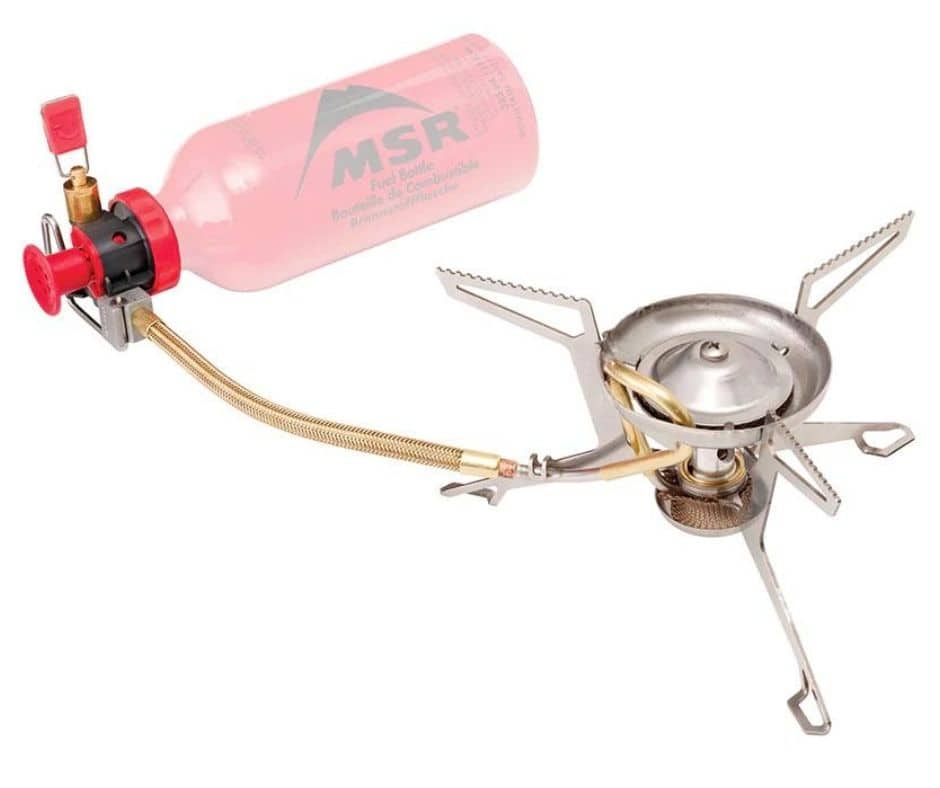
MSR Whisperlite International
Best for Travel and Cold Conditions
Fuel type: Multifuel
Weight: 310g
Boil time (1L): 4 minutes
What I like: Performs well at high altitudes and in extreme cold, sturdy base, multiple fuel options.
What I dislike: Fuel bottle sold separately.
The MSR Whisperlite International multi-fuel stove is an incredibly versatile piece of camping equipment, built with nearly 20 years of proven field use and feedback in mind.
Its one-piece, stamped stainless steel leg assembly enhances stability, reduces weight, and simplifies maintenance. Additionally, subtle engineering refinements have been made to increase its overall efficiency. The result is a reliable and efficient multi-fuel stove that is the perfect choice for backpackers and travellers exploring different parts of the world.
The Whisperlite International stove stands out among its competitors due to its impressive performance and reliability, making it the top choice for globetrotting backpackers who require a stove that can handle different types of fuel sources.
Whether you’re trekking through remote wilderness or camping in high altitudes, the Whisperlite International stove is built to handle anything.
Upgrade: The MSR Whisperlite International Combo is the same great stove but includes a 590ml fuel bottle. Even better still, the MSR Whisperlite Universal is a hybrid fuel cooker for both liquid fuel and cartridge fuel.
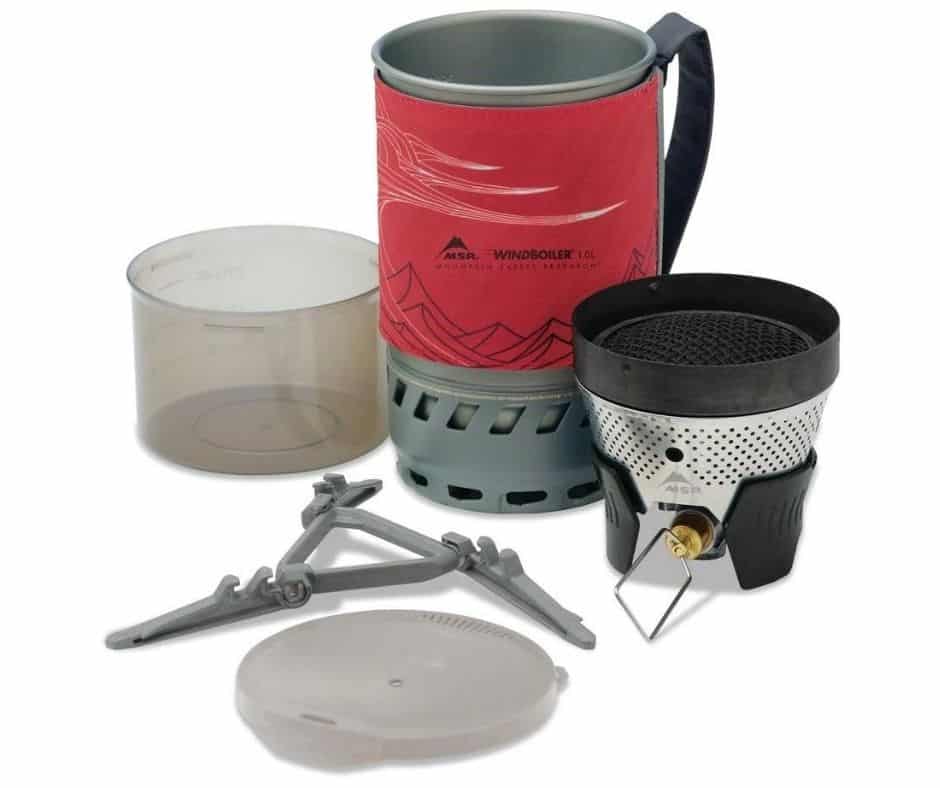
MSR WindBurner Stove System
Best for Wind Resistance
Fuel type: Butane/propane gas canister
Weight: 440g
Boil time (1L): 4.5 minutes
What I like: Excellent performance in windy conditions,
What I dislike: Heavy and bulky for backpacking, no built-in igniter.
The WindBurner Stove System is an exceptional piece of camping equipment. It is perfect for both backcountry adventures and weekend camping trips. With its radiant burner and enclosed, windproof design, it is capable of boiling water rapidly and operating efficiently in harsh weather conditions that would leave conventional burners struggling.
One of the best features of this stove system is the integrated cookware that comes with a built-in heat exchanger. This allows for the efficient transfer of heat to the lock-on pot, enabling campers to enjoy a hot meal or drink quickly after a long day of hiking, biking, or paddling. The all-in-one system nests inside its pot for easy packing and assembly, freeing up more time for campers to enjoy their adventure.
Another impressive aspect of the WindBurner Stove System is its ultra-efficient performance. The windproof radiant burner and pressure regulator ensure that the stove maintains its performance in windy and cold conditions, resulting in faster boil times and greater fuel efficiency than conventional stoves.
Overall, the WindBurner Stove System is a must-have for any camping enthusiast who values efficiency, convenience, and durability in their camping gear.
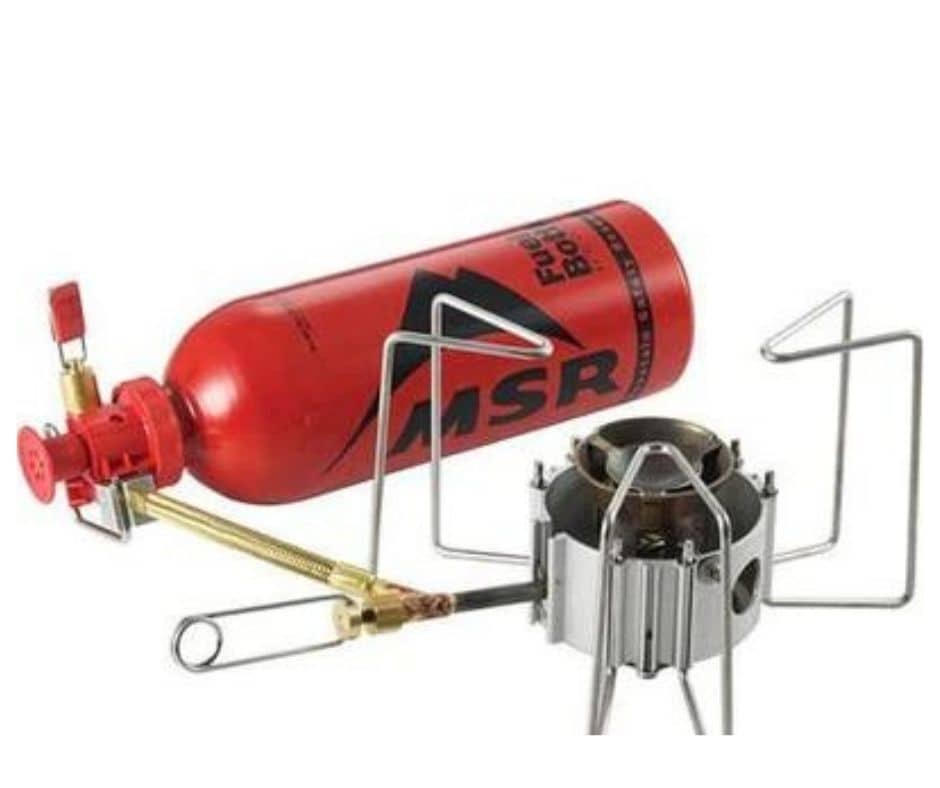
MSR Dragonfly
Fuel type: Multifuel
Weight: 330g
Boil time (1L): 3.5 minutes
What I like: Can handle larger pots, precise flame control, tough and stable
What I dislike: Requires routine maintenance.
The MSR Dragonfly Stove is a lightweight, compact and easy-to-use stove that is perfect for the solo hiker or adventure seeker. The burner head can be removed from its base and used with any liquid fuel canister (for example, MSR IsoPro), so you don’t need to carry extra fuel bottles when you’re on longer trips away from civilization. The flame control knob allows you to adjust how much heat you want going into your pot or pan, making it ideal for simmering soups or sauces while still being able to boil water quickly if needed.
Upgrade: The MSR Dragonfly Combo is also available if you would prefer to purchase the stove with a fuel bottle.
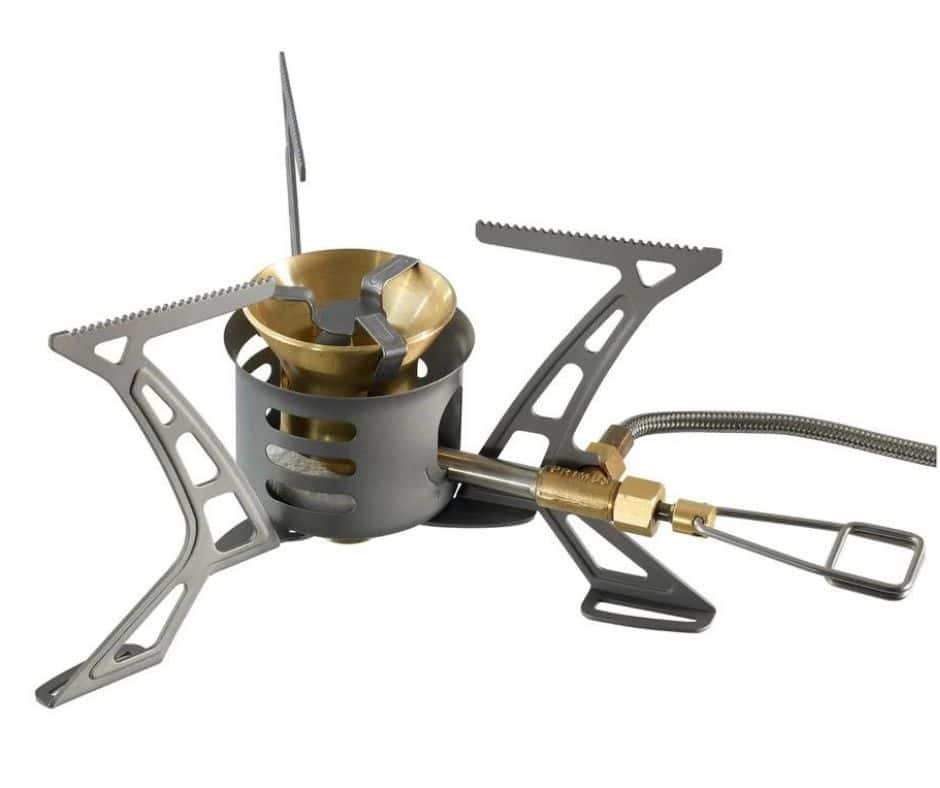
PRIMUS OmniLite Ti
Fuel type: Multifuel
Weight: 340g
Boil time (1L): 4 minutes
What I like: Hybrid fuel cooker for both liquid fuel and canisters, lightweight, sturdy base.
What I dislike: Requires regular maintenance, expensive
The OmniLite Ti stove is a reliable and sturdy piece of camping equipment that is smaller, lighter, and more fuel-efficient than its predecessor, the award-winning OmniFuel. The titanium windscreen and pot supports provide excellent stability while also keeping the stove lightweight. The stove can run on a variety of fuels, including gas, gasoline/petrol, diesel, kerosene/paraffin, and aviation fuel, making it a versatile choice for any camping trip.
The separate control knob allows campers to adjust the flame to their desired heat level, even while wearing gloves. The pack size is minimal, making it ideal for one or two eco-conscious campers heading out on an adventure. The OmniLite Ti stove comes with a multi-tool that includes a cleaning needle, a foldable windscreen, a heat reflector, a 0.35 l fuel bottle, and a durable storage bag.
Overall, the OmniLite Ti stove is an excellent choice for any camping enthusiast looking for a reliable, fuel-efficient, and eco-friendly stove.
A compact, lightweight cooking system that easily fits in your backpack making it perfect for one or two people on an overnight trip.
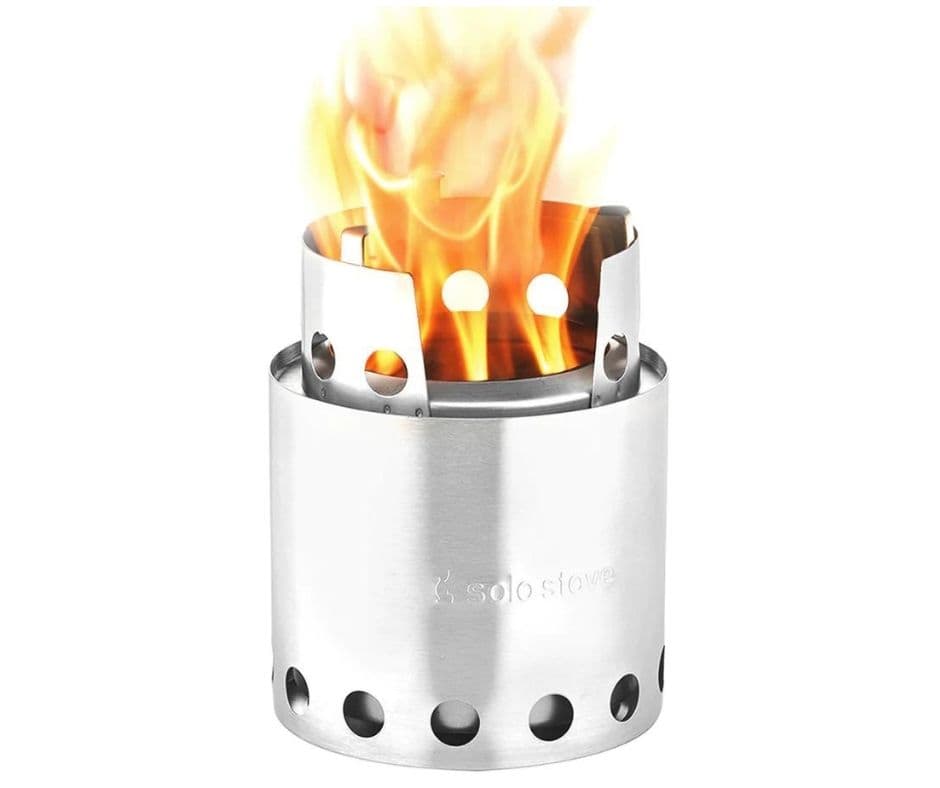
Solo Stove Lite
Fuel type: Wood
Weight: 255g
Boil time (1/2L): 2.5 minutes
What I like: Simple and efficient, no need to carry fuel, performs well in windy conditions.
What I dislike: Expensive, can’t control the flame.
The Solo Stove Lite is an excellent alternative-fuel option for those who want to keep their pack weight low. This stove uses wood, alcohol, or tablet-burning design, enabling hikers to ditch bulky gas canisters and bring smaller containers of fuel or forage for natural resources to burn.
The Solo Stove Lite is a versatile wood-burning stove that also doubles as a windscreen and pot stand. Its double-wall design recirculates hot air and provides direct oxygen to the embers for faster boiling times and higher efficiency.
Although the Solo Stove Lite is not the lightest or most packable stove solution, it is an excellent option for hikers who are curious about ultralight gear.
While alternative-fuel designs may not match liquid or canister stoves in terms of power and boil time, they are perfect for leisurely camping. In conclusion, the Solo’s Stove Lite is a great introduction to alternative-fuel stoves, and it is easy to maintain.
Other Camping Stoves to Consider
Although the following stoves didn’t make our top picks list, they are still very popular options and have some great features. It’s possible that one of these stoves could be the perfect fit for your needs.
- Jetboil ZIP Cooking System – A budget-friendly integrated canister stove that is efficient in getting the job done
- MRS Reactor Stove System – Great stove for harsh conditions and strong winds although not very cheap.
- OPTIMUS Crux Lite – Powerful burner with precise flame control for simmering and piezo device for ignition.
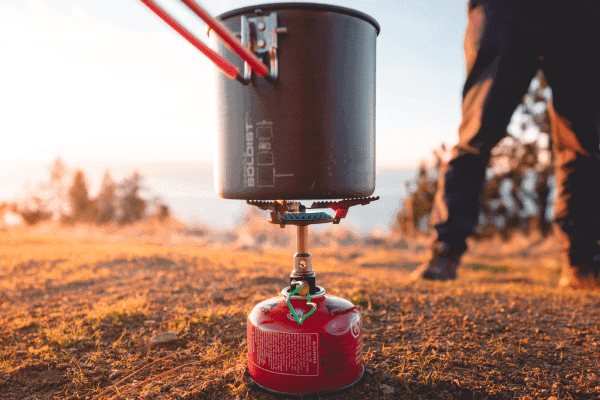
Types of Camping Stoves
There are a few factors to consider when choosing a camping stove, so let’s first take a look at the different types of camping stoves available. When choosing a camping stove you should also take into consideration the availability and cost of the fuel in the area where you’ll be camping.
Canister Stoves
Canister stoves are one of the most popular types of camping stoves because they are lightweight, compact, and easy to use.
They use pre-pressurized canisters of fuel that can be easily attached to the stove. Canister stoves are ideal for backpackers and solo campers who need a stove for boiling water or cooking simple meals.
Liquid Fuel Stoves
Liquid fuel stoves are more versatile than canister stoves because they can burn a variety of fuels such as white gas, kerosene, and diesel. They are more powerful than canister stoves and can be used to cook more complex meals. However, liquid fuel stoves are heavier and bulkier than canister stoves, making them better suited for car camping or base camp use.
Wood Burning Stoves
Wood-burning stoves are eco-friendly and don’t require any fuel to carry with you, making them ideal for long camping trips where you need to minimize the amount of gear you carry. They are also great for cooking over an open flame, but they do require a bit more effort to use since you need to collect and chop wood for fuel.
Solid Fuel Stoves
Solid fuel stoves are the most basic type of camping stoves and are often used as backup stoves. They use small fuel tablets made of compressed alcohol or hexamine, which can be lit with a lighter or match. Solid fuel stoves are lightweight and compact, but they don’t produce much heat and can take a while to boil water.
Important Factors to Consider
Fuel Type
The camping stove fuel type you choose significantly affects your stove’s performance and suitability for your adventure. Canister fuels are convenient and suited for lightweight stoves, ideal for simple meals, while liquid fuels like white gas offer higher BTUs for more intense cooking and colder conditions. Consider how your fuel choice impacts cooking power, portability, and performance in various environments to find the best match for your needs.
Cooking Power
The cooking power of a camping stove is measured in BTUs (British Thermal Units) and determines how quickly the stove can boil water or cook food. Canister stoves usually have a lower cooking power than liquid fuel stoves, but they can still be sufficient for simple meals. However, if you plan to cook more complex meals or for larger groups, a higher BTU rating may be necessary.
Weight and Size
The weight and size of a camping stove are important factors to consider, especially if you plan to carry the stove with you on backpacking trips. Canister stoves are generally the lightest and most compact, while liquid fuel stoves are heavier and bulkier. Wood-burning stoves and solid fuel stoves can also be lightweight, but they do require additional gear, such as a pot or pan stand.
Number of Burners
The number of burners you need depends on the size of your group and the complexity of the meals you plan to cook. Solo campers and backpackers may only need a single-burner stove, while larger groups may benefit from a stove with two or more burners.
Wind Resistance
Wind resistance is an important consideration, especially if you plan to camp in windy conditions. Some of the best camping stoves come with wind guards or shields to help protect the flame from wind gusts. Canister stoves are usually more wind resistant than liquid fuel stoves, but the use of a wind guard can help improve the performance of any stove.
Tips for Using a Camping Stove
No matter which camping stove you choose, here are some tips to help you use it safely and effectively:
- Always use the stove in a well-ventilated area and keep it away from flammable materials.
- Use a pot or pan with a lid to conserve fuel and speed up cooking times.
- Clean the stove after use to prevent the buildup of debris or residue that can affect performance.
- Bring extra fuel and spare parts, such as O-rings or pump seals, in case of a malfunction.
- Pack your camping stove carefully in your backpack to ensure it doesn’t get damaged.
- When packing for your next trip, don’t forget to include your camping stove. For more information on what gear to bring wild camping, check out my wild camping equipment guide here.
Final Thoughts
Choosing the best camping stove for your needs depends on various factors such as fuel type, cooking power, weight and size, number of burners, and wind resistance.
By considering these factors and reviewing our top picks, Hopefully, you can make an informed decision that will enhance your camping experience.
All that’s left to do now is work out what you’re going to cook.
To help I compiled some of my favourite camping meals or if you’re simply wanting for a quick hot meal at the end of a long day hiking why not try a freeze-dried meal?
Finally, don’t forget to grab our free camping checklist to help you get organised for any upcoming adventures.
Camping Stove FAQ
Do I need a camping stove for every camping trip?
It depends on your camping needs. If you plan to cook simple meals or boil water, a camping stove can be very useful. However, if you plan to eat cold food or rely on fire pits, a camping stove may not be necessary.
Can I use a canister stove in cold weather?
Yes, you can use a canister stove in cold weather, but you may need to keep the canister warm to maintain proper pressure and performance. I’d also recommend using a stand for your canister. Not only will this raise your canister off the cold ground, and it will provide extra stability.
How do I clean a camping stove?
Use a mild detergent and warm water to clean the stove after use. Be sure to remove any debris or residue from the burner and fuel lines. Avoid using abrasive materials that can scratch the surface of the stove.
Can I use a camping stove indoors?
No, camping stoves are designed for outdoor use only. Using a camping stove indoors can lead to carbon monoxide poisoning or fire hazards.
How often should I replace the fuel canister or bottle?
It depends on how often you use the stove and how much fuel you consume. Be sure to check the fuel level before each camping trip and bring extra fuel as needed. If the canister or bottle is damaged or shows signs of wear and tear, replace it before using the stove.

About the Author
Steve Cleverdon is an outdoor adventure specialist with 15+ years of hiking, camping, and paddle boarding experience. He has conquered Europe’s toughest trails including the GR20 in Corsica, walked 3,000km solo across New Zealand, and worked professionally in the outdoors industry. Steve’s gear reviews and recommendations are based on real-world testing across four continents, from coastal waters to mountain peaks. Learn more about Steve or get in touch.
